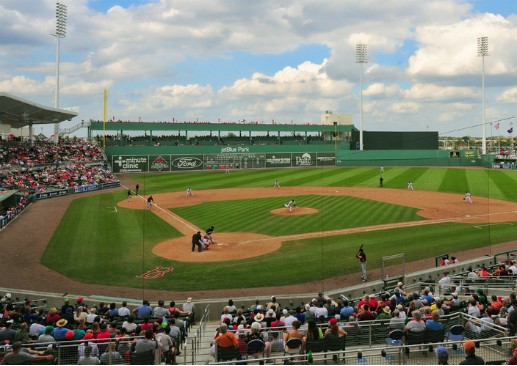For baseball fans, the long wait is over. Pitchers and catchers around Major League Baseball are reporting this week, and Spring Training — when big leaguers shake off their off season cobwebs — is about to be in full swing.
Spring Training has two leagues, one in Florida called the Grapefruit League, and the other in Arizona called the Cactus League, and its season lasts a little more than a month. This year’s Grapefruit League will span 35 days from March 1-April 4.
Despite Spring Training’s short lifespan every year, the competition among localities to attract and keep Major League teams in its neighborhoods is fierce.
In summer 2010, Florida’s Lee County sold $81 million in bonds to keep the Boston Red Sox in the city of Fort Myers. Twenty years earlier, the municipality had built the team a brand new stadium, but now the Red Sox were on the hunt for a new one.
The Red Sox, worth more than $800 million, flirted with other teams before it made a decision. That is a typical play, according to Governing, to drive up competition and receive lucrative benefits from local governments.
And this tactic works. It definitely did for the Red Sox, who got $81 million from Lee County, which doesn’t even include the cost of new infrastructure Fort Myers had to pay to build it.
The city hadn’t even paid off the $17.5 million in debt it owed from building the old stadium that was erected in 1993 when the new deal was struck.
Localities bend over backwards for MLB teams because of eye-opening studies like the one conducted by the Cactus League Baseball Association in late 2012.
The report found that Spring Training accounted for $422 million in economic impact for Arizona, and 56 percent of the 1.7 million fans who attended games in 2012 were from outside the state.
The math seems obvious at first glance: Build a multi-million dollar facility for a popular professional team and watch the return on your investment grow each year through tourism and various tax revenues. Publicity for your city and quality of life benefits are also positives in the equation.
Although there’s no denying the latter benefits of a Spring Training stadium, the former benefits are murky at best once you read between the lines.
As I’ve written before, the cost of building a professional sports stadium does not end once the building has been constructed. New roads, water mains, additional security and other overhead are reoccurring costs that typically fall on the local government. There’s also contingency costs for building degradation as the stadium ages to factor in too.
What’s more is it’s common for a team to completely avoid paying rent or even sharing ticket and concession revenue with its host city.
Take Winter Haven, Fla., and the Cleveland Indians, which Governing highlighted below:
In the case of Winter Haven, Fla., where the Cleveland Indians trained from 1993 to 2008, the economics of spring training simply didn’t work out. The team initially relocated to the city of 35,000 after Hurricane Andrew damaged a newly-built stadium in Homestead, Fla. that was supposed to house the team. The Red Sox – which had called Winter Haven home since 1966 – had just left. “The city was desperate for a team, and the Indians were desperate for a home,” says Michael Stavres, director of community services for Winter Haven.
When the team left, Winter Haven was already giving the Indians a sweet deal — the team didn’t pay rent, and it kept the bulk of revenue from ticket sales, concessions, parking and advertising. Meanwhile, the city paid for the operational costs of the stadium in full, which Stavres says cost around $800,000 annually. “Spring training is extremely expensive,” Stavres says.
Increased tourism and sales tax revenues don’t cover the costs of these sky-high expenses in many cases.
When the Indians left, for instance, Winter Haven’s sales tax revenue fell by $133,000, a fraction of the stadium’s $800,000 operating cost.
Charlotte County, Fla., funded $27.2 million in stadium renovations for the Tampa Bay Rays in 2009, and last year they released a study announcing that it generated approximately $21 million in economic impact thanks to increased tourism.
When Noah Pransky contacted the author of the study, however, he admitted that most of the stadium’s attendees came to Charlotte County for the beaches and weather, not baseball. Seeing big leaguers close up was just icing on the cake for most vacationers, apparently.
USA TODAY Sports conducted an interesting analysis of the cost-to-revenue ratios for cities hosting Cactus League teams in 2013, and found that most localities spent more on stadiums than revenues received.
Here are those numbers:
Peoria Sports Complex: Costs: $4.3 million. Revenue: $2.7 million. Subsidy: $1.6 million.
Camelback Ranch (Glendale)*: Costs: $147,992. Revenue: $129,110. Subsidy: $18,882. *Numbers from 2009 to 2012.
Surprise Stadium: Costs: $3.5 million. Revenue: $1.7 million. Subsidy: $1.8 million.
Goodyear Ballpark: Costs: $2.9 million. Revenue: $1.1 million. Subsidy: $1.8 million.
Phoenix Municipal Stadium: Costs: $1.7 million. Revenue: $532,097. Subsidy: $1.2 million.
Maryvale Baseball Park (Phoenix): Costs: $1.8 million. Revenue: $628,023. Subsidy: $1.2 million.
Tempe Diablo Stadium: Costs: $1.2 million. Revenue: $437,234. Subsidy: $766,439.
Hohokam Stadium (Mesa): Costs: $7.9 million. Revenue: $6.43 million. Subsidy: $1.47 million.
Scottsdale Stadium: Costs: $1.34 million. Revenue: $509,427. Subsidy: $837,422.
It’s hard to argue for direct economic benefits of Spring Training stadiums. What’s not quantifiable, however, is the quality of life and increased publicity these teams afford cities in Florida and Arizona.
STORY IDEAS











